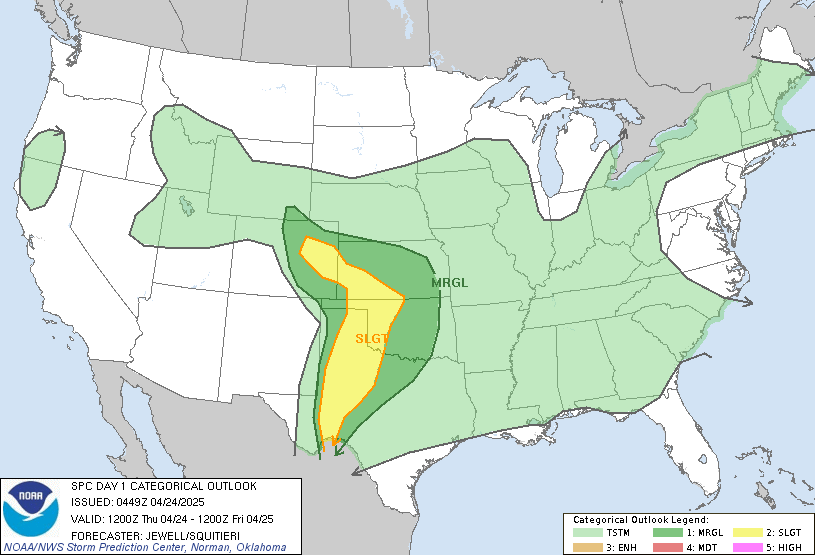LIVE MAP (ABOVE) ... SPC 1300Z Day 1 Outlook
Day 1 Convective Outlook
NWS Storm Prediction Center Norman OK
0751 AM CDT Fri Oct 18 2024
Valid 181300Z - 191200Z
...THERE IS A MARGINAL RISK OF SEVERE THUNDERSTORMS OVER PARTS OF
THE SOUTHERN ROCKIES AND SOUTHERN HIGH PLAINS...
...SUMMARY...
Isolated severe hail, damaging gusts and a tornado or two will be
possible this afternoon and evening over parts of the southern
Rockies and southern High Plains.
...Synopsis...
In mid/upper levels, a heretofore progressive and high-amplitude
pattern will slow down temporarily, across the western half of the
CONUS. A strong trough is apparent in moisture-channel imagery from
the northern Rockies south-southwestward across the Great Basin to
near the lower Colorado River Valley. A 500-mb low is forming along
the trough in NV -- and will deepen through the period while
anchoring an increasingly pronounced and slower-moving cyclone. By
00Z, the low should be over central AZ between FLG-PHX, then wobble
erratically over the same area through the remainder of the period.
At 11Z, the surface analysis showed a cold front from northwestern
MN, through a low between PIR-HON, then southwestward to another low
near AKO and into central CO. This front should shift slowly
southeastward through the period, to a position from northeastern MN
to northeastern NE to near RTN by 12Z. There it should connect to
another cold front now analyzed from a surface low over southeastern
UT, southwestward across northern/southwestern AZ. The western
front should move east-southeastward into central NM tonight, then
decelerate in step with the associated mid/upper cyclone. A vast,
continental anticyclone surrounds a high analyzed over western PA,
and covers most of the CONUS from the Mississippi Valley eastward,
with ridging southwestward across south TX. The high should remain
over the interior Mid-Atlantic region through the period, while
ridging persists southwestward through south TX.
...Southern Rockies/High Plains region...
A band of convection -- now producing considerable lighting from
southeastern UT into northern AZ -- should persist through much of
the period and shift eastward-southeastward, reaching from the San
Juan Mountains of southwestern CO across much of western NM between
00Z-03Z this evening. While isolated strong gusts or small hail may
occur with this partly frontally forced activity, very limited
buoyancy should preclude an organized severe threat. Farther east,
isolated to widely scattered thunderstorms should form in the warm
sector this afternoon, over and near the ranges from the Guadalupe
Mountains northward to the east side of the Sangre de Cristos.
Convection also may develop over adjoining Plains, given diurnal
heating in a weakly capped setting that lacks an antecedent EML.
Some of this activity may become supercellular amidst increasing
deep shear, with isolated damaging gusts and severe hail possible.
Tornado potential still appears marginal.
A host of mostly offsetting factors continue in the forecast
environment in and near the outlook area today, keeping the
unconditional severe probabilities in the marginal range for this
cycle. Thermodynamically, the immobility and intensity of the
low-level anticyclone over the East will limit favorable moisture to
a narrow, only partially Gulf-modified return-flow corridor through
the period. 50s F surface dewpoints -- already common at lower
elevations in eastern NM, should mix into the 40s F where diurnal
heating is most sustained today over the Plains. Upper 40s to lower
50s dewpoints may persist farther northwest under more persistently
cloudy areas, leading to greater RH and lower LCL, but amid cooler
surface temperatures. However, at higher elevations, this still may
support surface-based effective-inflow parcels. With the coolest
midlevel temperatures and strongest DCVA aloft lagging closer to the
cyclone core, and mostly behind the low-level cold front, poor
midlevel lapse rates will limit buoyancy over the region. This, and
lack of richer moisture, should keep MLCAPE generally in the 300-800
J/kg range -- and highly variable depending on elevation and patchy
heating/mixing.
Vertical shear amid southwest flow aloft will strengthen through the
evening along/ahead of the western frontal zone as the cyclone digs
into AZ. Enlarging hodographs and low-level shear will accompany a
strengthening low-level jet and greater moisture this evening and
tonight over much of eastern NM, along/ahead of the slow-moving
frontal convective arc. However, this also will coincide with
nocturnal boundary-layer stabilization and likely an increasingly
messy convective mode. A window of tornado potential may exist from
late afternoon into early evening during that transition, especially
at higher elevations of the Plains/mesa country, but still appears
too isolated and conditional for more than marginal probabilities.
..Edwards/Goss.. 10/18/2024
Read more CHECK UPDATE ZOOM GRAPHIC
http://dlvr.it/TFTcD4
Windy.com Temps | Gusts | WU KORD KPWK |
CLICK for this month's BIG night sky ... | RADAR FULL MAP SCREEN |
|---|
MOBILE DEVICE? Turn sideways. Weather conditions directly above are near Lakefront. Top tabs refer to O'Hare (official).
Archives for the SPC Convective Outlook are updated daily (approximately) with a live map at the beginning of each article. Follow the link at the end of the article to check for current updates on the NOAA/NWS Storm Prediction Center website. Also, see Archives for Chicago's hourly weather data on CARDINAL NEWS Magazine.
CONVECTIVE | TORNADO | WIND | HAIL
O'Hare International Airport KORD
(Arlington Heights South)
Chicago Executive Airport KPWK
(Arlington Heights North)
Friday, October 18, 2024
SPC Oct 18, 2024 1300 UTC Day 1 Convective Outlook
SUNRISE AND SUNSET TIMES IN UTC (if you're not logged in to Google)
CHICAGO UTC-6 during CST (Central Standard Time, e.g., winter)
CHICAGO UTC-5 during CDT (Daylight Savings Time, e.g., summer)
CHICAGO UTC-6 during CST (Central Standard Time, e.g., winter)
CHICAGO UTC-5 during CDT (Daylight Savings Time, e.g., summer)





















